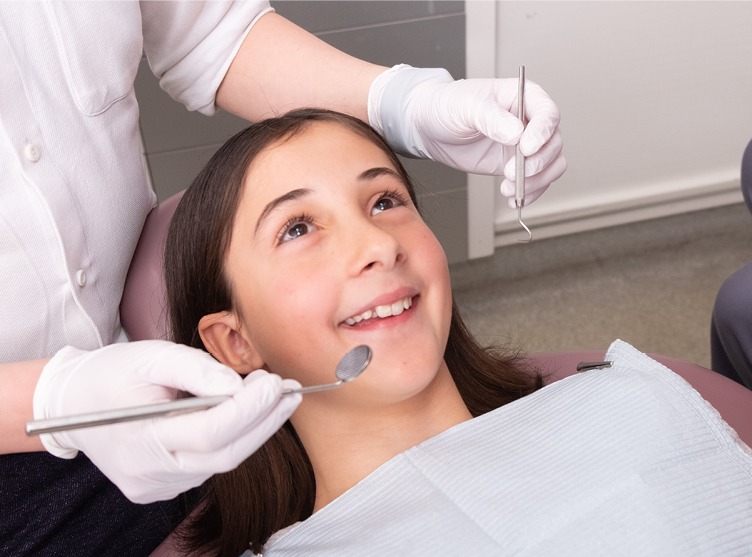
When it comes to orthodontics, we’re big believers in the idea that prevention is better than cure, which is why we encourage regular check-ups for children. Crooked teeth can be a real problem, no matter how old you are or how great your oral hygiene is. They can also cause a blow to self-esteem, because misaligned and unusually placed teeth are considered to be inferior.
That’s why we keep such a close eye on the development of adult teeth in children. As soon as the permanent teeth have begun to emerge, their growth and formation can be tracked in order to make sure that they are completely healthy. If crooked teeth are found, childhood is the perfect time to start taking corrective measures as the mouth is still growing.
We know getting braces can be a daunting experience for young people, but it doesn’t have to be scary! With the right information and advice, dental braces can be a walk in the park at any age.
What happens first?
At the first visit, the orthodontist will thoroughly examine your child’s teeth, mouth, and jaw. He or she may ask your child to bite the teeth together and may also ask questions about whether your child has problems chewing or swallowing, or has ever had clicking or popping of the jaw.
The orthodontist may take X-rays of the mouth and teeth to see how the teeth are positioned and whether any permanent teeth still need to come in. He or she also may make a mold (or impression) of your child’s teeth by pressing a tray of gooey material into the top and bottom teeth. When the mold is removed and the material hardens, the result is a replica of your child’s teeth that will allow the orthodontist to decide which treatment options are best.
Type of Braces
Braces correct alignment problems by putting steady pressure on the teeth, which eventually moves them into a straighter position.
Most kids just need braces with brackets, wires, and rubber bands. The brackets attach to the teeth and are connected by a wire and rubber bands. The wire is tightened bit by bit over time to slowly help line the teeth up properly. The rubber bands also come in fun colors that kids can choose. Though metal braces are still used, so are clear ceramic braces, which are much less noticeable. Some even go behind the teeth (lingual braces).
Clear removable braces that move teeth with sets of plastic trays called aligners (rather than wires and rubber bands) are also available, but these are only right for some people.
Some kids may need other devices, too, such as headgear (don’t worry — this is usually worn only at night!). Headgear uses a horseshoe-shaped wire that attaches to the back teeth, providing stronger force to move the teeth. The orthodontist also might recommend that your child have one or more teeth removed to create more space in his or her mouth.
Once the braces are on, your child will have to visit the orthodontist every few weeks for monitoring and adjustments.
How long does treatment take?
How long your child will need to wear braces depends on their customised treatment plan, but the average length is about 2 years. After that, your child might wear a specially molded retainer — a small, hard piece of plastic with metal wires or a thin piece of plastic shaped like a mouthguard. Retainers keep the teeth from wandering back to their original places.
What do I do if my child is scared of orthodontic treatment?
Kids being afraid of the orthodontist is normal. They may have heard scary stories or are scared of the idea of being in pain or of physical changes. In our experience, there are several things you can do to alleviate this.
Listen to their fears
No one likes to be ignored, so being sensitive to your child’s fear will let them feel heard and more secure. There are a variety of worries that come with an orthodontist’s appointment.
For example, pain is usually the number one fear, so it may be a good idea to be transparent about potential discomfort. It’s crucially important to be honest with them as you explain the process, while also keeping their fears in mind.
Choose a child-friendly orthodontist
While no orthodontist is deliberately mean to children, finding an especially child sensitive orthodontist will make everything go smoother. Luckily, the Smile Team orthodontists know exactly how to put children at ease, and do everything they can to make them feel better about the whole process.
No surprise appointments
No one likes getting surprised by an appointment, especially if they’re already nervous. Going back to aiming for total transparency, it’s good to let them know a few days before the appointment. However, you don’t want to let them know too early, because that’ll give them more time to stew in their anxiety.
We recommend scheduling the first orthodontic consultation for your child at around 7 years old. If it’s time for your little one to come and have their teeth looked at, schedule them an appointment here.